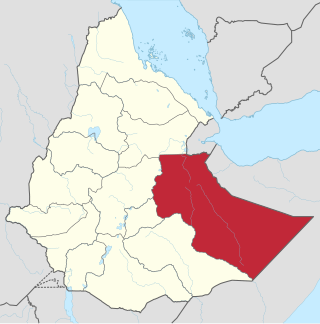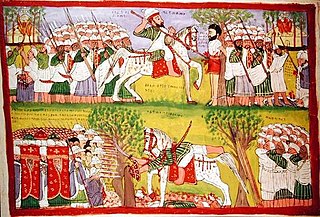
Harar, known historically by the indigenous as Harar-Gey or simply Gey, is a walled city in eastern Ethiopia. It is also known in Arabic as the City of Saints.

The Adal Sultanate, also known as the Adal Empire or Bar Saʿad dīn, was a medieval Sunni Muslim Empire which was located in the Horn of Africa. It was founded by Sabr ad-Din III on the Harar plateau in Adal after the fall of the Sultanate of Ifat. The kingdom flourished c. 1415 to 1577. At its height, the polity under Sultan Badlay controlled the territory stretching from Cape Guardafui in Somalia to the port city of Suakin in Sudan. The Adal Empire maintained a robust commercial and political relationship with the Ottoman Empire. Sultanate of Adal was alternatively known as the federation of Zeila.

Dire Dawa is a city in eastern Ethiopia near the Somali Region and Oromo border and one of two chartered cities in Ethiopia. Dire Dawa alongside present-day Sitti Zone were a part of the Dire Dawa autonomous region of the Somali Region stipulated in the 1987 Ethiopian Constitution until 1993 when it was split by the federal government into a separately administered chartered city.

Hararghe was a province of eastern Ethiopia with its capital in Harar.

The Sultanate of Ifat, known as Wafāt or Awfāt in Arabic texts, or the Kingdom of Zeila was a medieval Sunni Muslim state in the eastern regions of the Horn of Africa between the late 13th century and early 15th century. It was formed in present-day Ethiopia around eastern Shewa in Ifat. Led by the Walashma dynasty, the polity stretched from Zequalla to the port city of Zeila. The kingdom ruled over parts of what are now Ethiopia, Djibouti, Somaliland, Somalia.
The Walashma dynasty was a medieval Muslim dynasty of the Horn of Africa founded in Ifat. Founded in the 13th century, it governed the Ifat and Adal Sultanates in what are present-day, Somalia, Djibouti, Eritrea and eastern Ethiopia.

The Battle of Chelenqo was an engagement fought on 9 January 1887 between the Abyssinian army of Shewa under Negus Menelik and Emir 'Abd Allah II ibn 'Ali 'Abd ash-Shakur of Harar. The Harari forces were routed, and Negus Menelik afterwards occupied and annexed the city of Harar.

The Ethiopian–Adal War or Abyssinian–Adal War, also known in Arabic as Futūḥ Al-Ḥabaša, was a military conflict between the Christian Ethiopian Empire and the Muslim Adal Sultanate from 1529 to 1543. The Christian Ethiopian troops consisted of the Amhara, Tigrayans, Tigrinya and Agaw people, and at the closing of the war, supported by the Portuguese Empire with no less than four hundred musketeers. The Adal forces were composed of Harla, Somali, Afar, as well as Arab and Turkish gunmen. Both sides would see the Maya mercenaries at times join their ranks.

The Karanle are a Somali clan, forming one of the six branches of the larger Hawiye clan. The Karanle are geographically spread out across three countries: Somalia, Ethiopia, and Kenya. Among all of the Karanle inhabited regions of the Horn of Africa, Ethiopia is the where the majority of the clan reside. In Ethiopia, the Karanle are mainly found in Harar, Hubat, and Babile but they also inhabit the Somali Region, Dire Dawa and surrounding regions. The majority of the Karanle Sub-clans predominantly reside in the regions of Ethiopia where the Somali population is predominant, with the exception of the Murusade Sub-clan, who reside in central and southern Somalia.
The Argobba are an ethnic group inhabiting Ethiopia. A Muslim community, they are spread out through isolated village networks and towns in the north-eastern and eastern parts of the country. Group members have typically been astute traders and merchants, and have adjusted to the economic trends in their area. These factors have led to a decline in usage of the Argobba language. Argobba are considered endangered today due to exogamy and destitution as well as ethnic cleansing by the Abyssinian state over the centuries.

The Harari people are a Semitic-speaking ethnic group which inhabits the Horn of Africa. Members of this ethnic group traditionally reside in the walled city of Harar, simply called Gēy "the City" in Harari, situated in the Harari Region of eastern Ethiopia. They speak the Harari language, a member of the South Ethiopic grouping within the Semitic subfamily of the Afroasiatic languages.
The Harla, also known as Harala, Haralla are an ethnic group that once inhabited Ethiopia, Somalia, and Djibouti. They spoke the now-extinct Harla language, which belonged to either the Cushitic or Semitic branches of the Afroasiatic family.

The Makhzumi dynasty also known as Sultanate of Shewa or Shewa Sultanate, was a Muslim kingdom in present-day Ethiopia. Its capital Walale was situated in northern Hararghe in Harla country. Its territory extended possibly to areas west of the Awash River. The port of Zeila may have influenced the kingdom. The rise of the Makhzumi state at the same time resulted in the decline of the Kingdom of Axum. Several engravings dating back to the 13th century showing the presence of the kingdom are found in Chelenqo, Bale, Harla near Dire Dawa and Munesa near Lake Langano.

The Emirate of Harar was a Muslim kingdom founded in 1647 when the Harari people refused to accept Imām ʿUmardīn Ādan as their ruler and broke away from the Imamate of Aussa to form their own state under `Ali ibn Da`ud.
The Harla kingdom was a sixth-century Harla state centered around what is present day eastern Ethiopia. The kingdom had trading relations with the Ayyubid and Tang dynasties. It also established its own currency and calendar. The kingdom is mentioned by Ethiopian as well as Arab medieval writers including al-Mufaddal ibn Abi al-Fada'il and Ibn Sa'id al-Maghribi. Timothy Insoll identifies the Harlaa ruins to be Hubat the capital of the Harla state, a subordinate of Ifat Sultanate in the thirteenth century and later under the Adal Sultanate as an autonomous tribal confederation in the fifteenth century. Early Muslim states in the Horn of Africa such as the Makhzumi dynasty had their bases within Harla territories. According to historian Mohammed Hassen a power struggle had developed in the early sixteenth century between Harla state leaders and the Walashma dynasty. Researcher Dominico Patassini states the Harla kingdom was succeeded by Harar city-state in the sixteenth century.

Gidaya, also known as Gedaya or Jidaya was a historical Muslim state located around present-day eastern Ethiopia. The state was positioned on the Harar plateau and a district of Adal region alongside Hargaya and Hubat polities. It neighbored other states in the medieval era including Ifat, Mora, Hadiya, Fatagar, Biqulzar, Fedis and Kwelgora.
Adal, known as Awdal or Aw Abdal was a historical Muslim region in the Horn of Africa. Located east of Ifat and the Awash river as far as the coast, and including Harar as well as Zeila. The Zeila state often denoted Adal and other Muslim dominions in medieval texts.

Argobba Bari, more commonly known as Argob Bari meaning "Argobba gate" is one of five ancient gates of Harar, Ethiopia. This gate is also known as the gate of compassion. The gate, which is now located in the eastern part of the Old City, was named in memory of the Argobba people who fled from Ifat during their conflict with Abyssinia in the fifteenth century and settled outside the town of the lowlands in Aw Abdal.

Badro Bari, meaning "Badr gate" is one of five ancient gates of Harar, Ethiopia. It was named after the notable seventh century conflict in Islamic history called the Battle of Badr. The vicinity of the gate was the ground for the Malassay military drills for cadets.
The Battle of Webi River was fought in 1576 between the forces of Adal led by Muhammad ibn Nasir, and the Abyssinian army, under Sarsa Dengel. The outcome of this last war proved to be the end of the political importance of Harar, as the invading Muslim force was liquidated. This major defeat ended the Sultanate of Adal's status as a major military power and permanently ceased its aggression towards Ethiopia.














